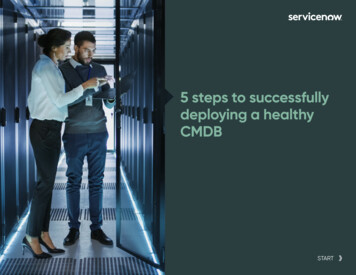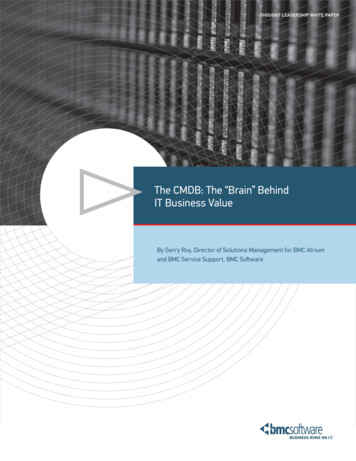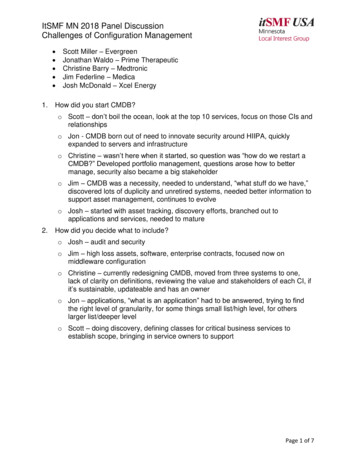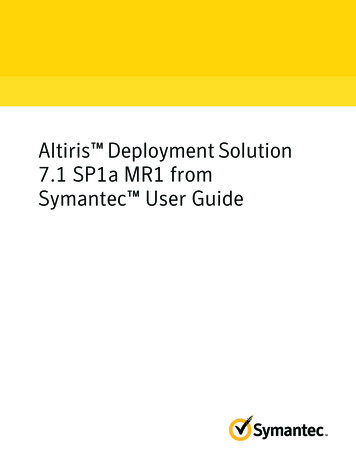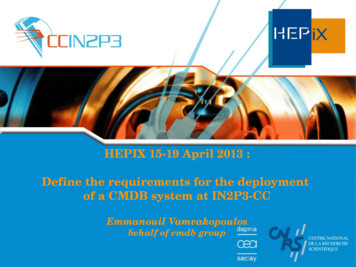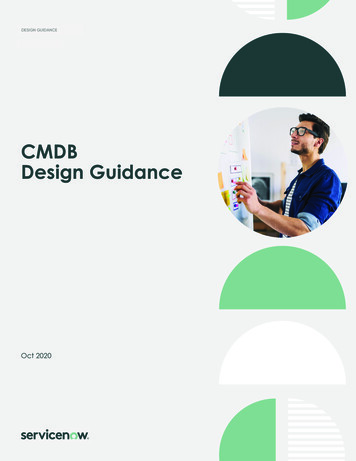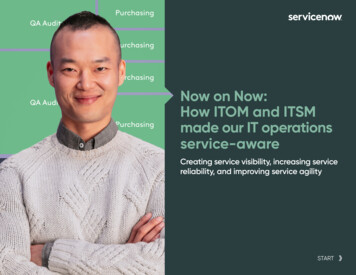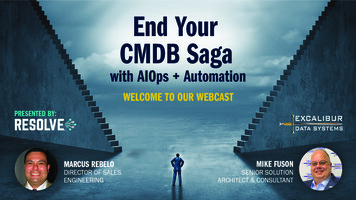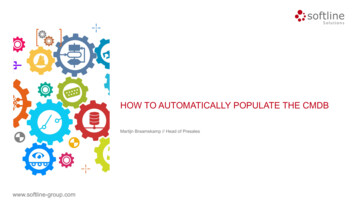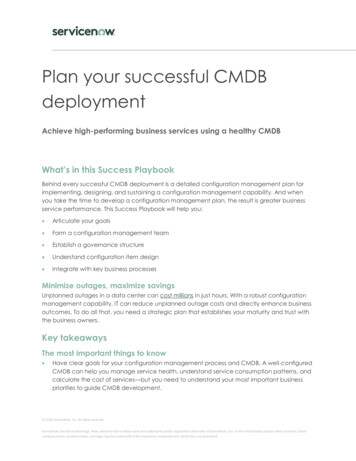
Transcription
Plan your successful CMDBdeploymentAchieve high-performing business services using a healthy CMDBWhat’s in this Success PlaybookBehind every successful CMDB deployment is a detailed configuration management plan forimplementing, designing, and sustaining a configuration management capability. And whenyou take the time to develop a configuration management plan, the result is greater businessservice performance. This Success Playbook will help you: Articulate your goals Form a configuration management team Establish a governance structure Understand configuration item design Integrate with key business processesMinimize outages, maximize savingsUnplanned outages in a data center can cost millions in just hours. With a robust configurationmanagement capability, IT can reduce unplanned outage costs and directly enhance businessoutcomes. To do all that, you need a strategic plan that establishes your maturity and trust withthe business owners.Key takeawaysThe most important things to know Have clear goals for your configuration management process and CMDB. A well-configuredCMDB can help you manage service health, understand service consumption patterns, andcalculate the cost of services—but you need to understand your most important businesspriorities to guide CMDB development. 2018 ServiceNow, Inc. All rights reserved.ServiceNow, the ServiceNow logo, Now, and other ServiceNow marks are trademarks and/or registered trademarks of ServiceNow, Inc., in the United States and/or other countries. Othercompany names, product names, and logos may be trademarks of the respective companies with which they are associated.
Start small and iterate. Build a solid inventory of CIs tied to specific use cases. If you findyourself populating your CMDB with items that don’t tie back your business priorities or usecases, you’re probably off track.The payoff of getting this rightA well-configured CMDB can save you as much as 40% in IT costs—and help you avoid the costsof unplanned outages.What you need to get started General knowledge of ITIL Knowledge of configuration management methodology Knowledge of the features and functions supported by the CMDBPlaybook overviewThe four stages toward a healthy CMDB:Stage 1 – Set your directionStage 2 – Build a team and a governance modelStage 3 – Design your configuration planStage 4 – Show your CMDB’s value to other organizationsThe takeaway – Manage service healthAt the end of these stages, you’ll see that the takeaway is your ability to manage service healthbetter than ever. You will also be able to understand: The distinction between business services that offer a competitive advantage (and requireinvestment) vs. those that are commoditized (and should be looked to for cost savings) Your technical debt and support risk profiles for services Consumption patterns for your services The technology architectures used to deliver your services The cost of your services, as well as your ability to deliver against SLAs 2018 ServiceNow, Inc. All rights reserved.ServiceNow, the ServiceNow logo, Now, and other ServiceNow marks are trademarks and/or registered trademarks of ServiceNow, Inc., in the United States and/or other countries. Othercompany names, product names, and logos may be trademarks of the respective companies with which they are associated.
Stage 1 – Set your directionClear configuration management goals, objectives, and outcomes are the keys todesigning a great configuration management capability that leads to a rock -solid CMDB.Designing a great configuration management capability starts with clear configurationmanagement goals, objectives, and outcomes. Make sure your configuration managementefforts are aligned to your business objectives.Write well-stated goals and objectivesCompanies with successful CMDB deployments always articulate what to accomplish, theirapproach, intended business outcomes, and their ongoing measurements of those outcomes.WhatWhat do you want to accomplish?HowDefine your approach, constraints, and assumptions.WhyWhat are the business outcomes that CMDB will support?MeasureHow do you know you're doing it right?Table 1: A quick way to set goals and objectivesStart by writing a list of use cases to focus your goals. These use cases should directly tie to thestrategic initiatives of your company. ServiceNow customers often start with these:QUESTIONS YOU'READDRESSINGMAPPED USE CASEHOW DOES THIS TIE BACK TOCMDB?An infrastructure componentbroke in the middle of datacenter migration. How wouldthis impact services?Data center migrationAccurate infrastructureconfiguration and its impacton business servicesWe need to changesomething in our data center.How will this affect ourbusiness?Change managementAccurate infrastructureconfiguration and its impacton business servicesOur monitoring tool notified usthat a metric has exceeded athreshold that happens to beCloud-first strategyMapping of cloud servicesalong with on-premisesinfrastructure 2018 ServiceNow, Inc. All rights reserved.ServiceNow, the ServiceNow logo, Now, and other ServiceNow marks are trademarks and/or registered trademarks of ServiceNow, Inc., in the United States and/or other countries. Othercompany names, product names, and logos may be trademarks of the respective companies with which they are associated.
in the cloud. How urgent is thisto our business?We're spending lots of moneyon our IT infrastructure. Whereare these componentsdeployed and for whatbusiness applications?Asset managementAccurate tracking ofinfrastructure and applicationsTable 2: Questions that customers ask when setting up key use cases tailored to support business initiativesto accelerate goals and objective definitionsCustomer exampleTable 3 shows you how one customer outlined goals and focused on key business priorities usingthe Why section.What Implement configuration managementHow Executed completely and accurately Done with automation Satisfies audit and compliance requirements Reduces technological complexity Improves planning, coordination, and communication of changes Moves us from application-centric to business-centric Understand the impact of changes proactively Support data center migration Enabler to digital transformation Support cloud first strategy Improved perception of trusted system of record Incident reductionWhyMeasureTable 3: A customer example of setting goals and objectivesThis document shows more examples of how to effectively set goals and objectives.EXPERT TIPWrite your goals so they help your organization achieve its strategic initiatives. 2018 ServiceNow, Inc. All rights reserved.ServiceNow, the ServiceNow logo, Now, and other ServiceNow marks are trademarks and/or registered trademarks of ServiceNow, Inc., in the United States and/or other countries. Othercompany names, product names, and logos may be trademarks of the respective companies with which they are associated.
Stage 2 – Build a team and a governance modelWhen you build your configuration management team and governance structure and getearly buy-in from executives, it helps create credibility and trust in your configurationmanagement process over the long term.The team should have autonomy to carry out configuration management responsibilities withoutbeing bogged down by daily support functions. This team should operate independently fromthe day-to-day “keep the lights on” support functions.With your team in place, define each member’s role, responsibilities, and authority. Thendocument these things to ensure they have the ownership and support to make the changesrequired.ROLERESPONSIBILITYTITLECM executive sponsorOversees configuration managementplan implementation in alldepartments within the companySenior executiveHas ownership and is accountablefor its strategic development; EnsuresCM plan is rolled outSenior managerManages delivery of CM services anddocumentation of operatingproceduresIT managerPerforms daily configurationmanagement tasks with minimaldirectionIT analystCCB process ownerCM process ownerCCB chairConfiguration managerFull CCB member/guestmemberCM system analystFull CCB member/guestmemberCM specialistFull CCB member/guestmemberPerforms daily configurationmanagement tasks with directionfrom CM system analystIT adminTable 4: Typical assignments for a configuration management teamTable 4 shows how one ServiceNow customer outlined its team’s roles and responsibilities beforedeploying the CMDB.To learn more about identifying and assigning roles, read this detailed guide. 2018 ServiceNow, Inc. All rights reserved.ServiceNow, the ServiceNow logo, Now, and other ServiceNow marks are trademarks and/or registered trademarks of ServiceNow, Inc., in the United States and/or other countries. Othercompany names, product names, and logos may be trademarks of the respective companies with which they are associated.
Implement governanceAs part of this team, ServiceNow customers form a configuration control board (CCB). The CCBserves as a steering committee to make sure there is always a good value proposition forconfiguration management efforts. The CCB is essential and is there to ensure your configurationmanagement project stays on track, from a value proposition perspective, and remainseffective for the company. Voting members of your CCB should be leadership team memberswho are directly accountable for the strategic initiatives of the IT department and close enoughto the day-to-day infrastructure support team efforts to understand the use cases.For an example of how our customers implement governance through a CCB, take a look at thisCCB Charter document.We’ve found that the titles and roles of the CM team vary in each company. For instance, theServiceNow IT infrastructure and operations team uses the RACI matrix (Responsible,Accountable, Consulted, Informed) to manage configuration management tasks. For example,when they publish a new configuration item (CI), each of the four members of the team ensuresthat updates are made successfully. Both the configuration manager and analyst areaccountable and responsible for publishing the new CI; while the CI owner and process ownersare informed of this change to ensure all systems are updated and communicated tostakeholders. 2018 ServiceNow, Inc. All rights reserved.ServiceNow, the ServiceNow logo, Now, and other ServiceNow marks are trademarks and/or registered trademarks of ServiceNow, Inc., in the United States and/or other countries. Othercompany names, product names, and logos may be trademarks of the respective companies with which they are associated.
ERProduce configuration management planCRR/ADefine CMDB structureCRR/ADetermine Cl selection guidelinesCRR/APopulate CMDBCR/APerform initial auditRR/ACBaseline CMDBIR/AIRR/ARR/AUSERCL OWNERProcess planning and designConfiguration identificationValidate update requestCValidate Cl attributesReview invalid attributesCRR/AUpdate CMDBCRR/APublish new Cl typeIRR/AIConfiguration controlValidate update requestCValidate Cl attributesIR/AR/ACIR/AIRR/ACreate or update configurationmanagement reportRR/AGenerate configuration management reportRR/ARR/AReview invalid attributesUpdate CMDBR/AStatus accounting and reportingAuthorize or reject report requestDistribute configuration management reportIVerification and auditApprove verification and audit requestExecute auditR/AReconcile with CMDBR/ADetermine corrective actionR/AInitiate corrective CMDB actionExecute corrective actionIR/A1R/AR: Responsible, A: Accountable, C: Consulted, I: InformedTable 5: ServiceNow IT infrastructure and operations team RACI matrix that is used to assign configurationmanagement team tasks 2018 ServiceNow, Inc. All rights reserved.ServiceNow, the ServiceNow logo, Now, and other ServiceNow marks are trademarks and/or registered trademarks of ServiceNow, Inc., in the United States and/or other countries. Othercompany names, product names, and logos may be trademarks of the respective companies with which they are associated.
One of our customers clearly documents tasks that require approval from their governanceboard and those that can be accomplished by the application support team. For instance,application support canmodify version, lifecycle, business owner, and relationships. While fieldslike business criticality, SLA, and operational status (live, retired, etc.) have to go through theboard for formal approval. We like this approach since it clearly identifies the responsibilities ofthe stakeholders.EXPERT TIPCreate a structured team and a steering committee to keep everyone focused on the goalsof keeping a business driven configuration management plan. 2018 ServiceNow, Inc. All rights reserved.ServiceNow, the ServiceNow logo, Now, and other ServiceNow marks are trademarks and/or registered trademarks of ServiceNow, Inc., in the United States and/or other countries. Othercompany names, product names, and logos may be trademarks of the respective companies with which they are associated.
Stage 3 – Design your configuration planStart small and grow gradually as you design your CMDB with configuration items.Take the time to familiarize yourself with the CMDB and its features and functions. Develop anunderstanding of the design options for the CMDB and the broader ecosystem of federatedsystems and data feeds.Your CMDB is populated with configuration items (CIs), which must be classified for you to havea properly managed CMDB. When you start this process, start small and grow gradually. Alsomake sure that there are no duplicate CIs.WHAT IS A CI?A CI is one of the most important components of your CMDB. It’s simply an application,infrastructure, or service component you’re managing. It can be a physical server, an apprunning on a virtual server, or a business service.Decide which CI classes and attributes you need to support the use cases you identified inStage 1. Most organizations start simple and make incremental improvements as they gainexperience. From this, you should be able to identify the types of CI classes you will need tomanage. You will need to make sure these CI classes are at the appropriate level—as in whatlevel of definition is meaningful to the use cases you identified earlier. As a generalrecommendation, start with using the CI classes defined out of the box for CIs that can bediscovered with the Now Platform . These CI classes have been vetted by thousands of ourcustomers and should contain all of the attributes your efforts will need.For example, you might start with a hardware CI class, so you assign some simple attributes: CPU,memory, etc. As you build your CMDB, you’ll map computers, servers, routers, switches, and soon. Each of these CIs will have attributes and each one of them will have relationships anddependencies.Heads up!Your CI tables can get out of control quickly if you don’tsimplify them! Keep their names intuitive so they are easy toidentify and remember. 2018 ServiceNow, Inc. All rights reserved.ServiceNow, the ServiceNow logo, Now, and other ServiceNow marks are trademarks and/or registered trademarks of ServiceNow, Inc., in the United States and/or other countries. Othercompany names, product names, and logos may be trademarks of the respective companies with which they are associated.
OUR CUSTOMERS START BY CLASSIFYING THESE CIS: Windows server Network router Linux server Network switch Firewall Storage Load balancer Application server DatabaseOne large insurance customer warns that it’s easy to add data to the CMDB but harder tomaintain the model.For CI classes that are not discoverable, you might need to extend an out-of-the-box class.Figure 1 depicts how the CMDB uses objectoriented inheritance in the creation of all CI classes.If you are using ServiceNow Discovery, it will find all the network infrastructure, applications, andservices and populate them into the CMDB. Dependency maps let you see where your CIssupport a critical service.For example, the loss of disk drives may take a database instance down, which affects therequisition service the HR department uses to order equipment for new employees. If you areusing ServiceNow Discovery or Service Mapping products, the dependencies betweendiscoverable CIs will be built for you automatically as the CMDB is updated by discoveryupdates. See Figure 2. 2018 ServiceNow, Inc. All rights reserved.ServiceNow, the ServiceNow logo, Now, and other ServiceNow marks are trademarks and/or registered trademarks of ServiceNow, Inc., in the United States and/or other countries. Othercompany names, product names, and logos may be trademarks of the respective companies with which they are associated.
Figure 2: ServiceNow CMDB dependency mapFor the logical “business layers” that are not discoverable, you will have to define therelationships between discoverable and non-discoverable CIs comprising your business model.For each CI class, you will need to make sure the CMDB is configured properly. Use CI ClassManager to configure the rules for each CI class to ensure you have all the necessaryinformation about your CIs in one place. The CMDB stores all the information you want tocapture and manage on an ongoing basis and can record relationships between attributes inthe CMDB.In order to manage changes to the CMDB, we recommend setting up configuration control thateliminates the risks of unnecessary tweaks to the CIs. Based on customer implementations, wesuggest that you proactively manage CIs and their dependencies when they’re added,deleted, and modified. When a business process like incident management requests a changeto the CIs, you should:1. Allow change requests via Change Management; you can easily do this using the ProposeChange feature if have ServiceNow Change Management enabled.2. Assign proper privileges to the authorized users to make changes; normally it’s a member ofyour team such as a CM analyst.3. Validate CI attributes against agreed criteria in your configuration management plan.4. Update the CMDB with the necessary changes and communicate them to stakeholders. 2018 ServiceNow, Inc. All rights reserved.ServiceNow, the ServiceNow logo, Now, and other ServiceNow marks are trademarks and/or registered trademarks of ServiceNow, Inc., in the United States and/or other countries. Othercompany names, product names, and logos may be trademarks of the respective companies with which they are associated.
EXPERT TIPStart by populating your CMDB with a solid inventory of CIs focused on specific use cases. Ifyou find yourself populating with items that do not tie back to your goal or use case, youare off track.Figure 3: ServiceNow CI Class Manager 2018 ServiceNow, Inc. All rights reserved.ServiceNow, the ServiceNow logo, Now, and other ServiceNow marks are trademarks and/or registered trademarks of ServiceNow, Inc., in the United States and/or other countries. Othercompany names, product names, and logos may be trademarks of the respective companies with which they are associated.
Stage 4 – Show your CMDB’s value to other organizationsWhen you integrate business processes, tie them back to your goals, and communicateproactively about changes to the CMDB, you make the CMDB a valuable asset to theorganization.You can show value to other organizations by tying back to the goals and objectives you setearlier. The value to others is if you can provide a line of sight from strategic business drivers tothe services offered to your customers to the technologies used to deliver your services to theactual operational infrastructure used to the total cost of your services.Start by integrating with key business processes such as asset management, incidentmanagement, etc.Set clear relationships with the various governance boards and align with business processesfrom the beginning. You can save 110,000 per hour or more on service outages when youdocument your relationship with other governance mechanisms.Start by mapping the four business processes listed in Table 6 to your configuration managementplan.Remember to practice configuration control that was set up in Stage 3 to ensure you take careof change requests from these business processes.Table 6: Four important business process integrationsCommunicate using the ServiceNow CMDB dashboardUsing the ServiceNow CMDB dashboard, your stakeholders get status updates and trackimportant changes. In this way, you’re able to share the health of the CMDB. 2018 ServiceNow, Inc. All rights reserved.ServiceNow, the ServiceNow logo, Now, and other ServiceNow marks are trademarks and/or registered trademarks of ServiceNow, Inc., in the United States and/or other countries. Othercompany names, product names, and logos may be trademarks of the respective companies with which they are associated.
Figure 4 is an example of the ServiceNow infrastructure and operation’s CMDB dashboard. TheServiceNow team uses this dashboard to manage the health of the CMDB and communicate itto business stakeholders.Figure 4: ServiceNow infrastructure and operations team uses CMDB dashboard toUse these major metrics to track your CMDB health:CompletenessTest for required and recommendedfields that are not populatedComplianceAudit the CMDB for its adherence topredefined certificatesCorrectnessTest against predefined data integrityrules such as identification rules,orphan CI rules, and stale CI rulesTable 6: CMDB health metricsSome ServiceNow customers use internal social media channels to share the CMDB dashboardwith hundreds of stakeholders who are then able to track changes and resolve inconsistenciesor problems quickly. The CMDB dashboard is a great way to track continual improvement anddata quality.The real value in communicating clearly is that both IT and the business can save millions ofdollars on unexpected outages and improve remediation when tracking CI changes among 2018 ServiceNow, Inc. All rights reserved.ServiceNow, the ServiceNow logo, Now, and other ServiceNow marks are trademarks and/or registered trademarks of ServiceNow, Inc., in the United States and/or other countries. Othercompany names, product names, and logos may be trademarks of the respective companies with which they are associated.
these business processes. With the CMDB dashboard, you can show other governing boards howa process has changed and what changes are needed in the configuration management plan.monitor health and makes it easy for stakeholders to see CMDB healthEXPERT TIPClear communication about changes in the configuration management plan to businessstakeholders is great for the long-term health of your CMDB.The takeawayManaged performance and service healthYou can now manage your CMDB health and keep critical services at maximumavailability. Be sure to document any crit ical services in the configuration managementsystem and CMDB that will impact your configuration management plan.Create a complete set of documents similar to what you create for a software engineeringlifecycle.Treat critical services inside the CMS as strategic applications for your business. Document thefollowing for every critical service: Requirements Logical design Physical design Test plan and test scripts Requirements Traceability Matrix Data dictionaryITIL V3 CONFIGURATION MANAGEMENT SYSTEMThe ITIL V3 Configuration Management System is a much broader system that combinesmany different data repositories.ServiceNow provides a great way to manage critical business services. But maintaining businessservice relationships with the underlying infrastructure is a continuous effort. Our customers often 2018 ServiceNow, Inc. All rights reserved.ServiceNow, the ServiceNow logo, Now, and other ServiceNow marks are trademarks and/or registered trademarks of ServiceNow, Inc., in the United States and/or other countries. Othercompany names, product names, and logos may be trademarks of the respective companies with which they are associated.
use Discovery, Service Mapping, and Event Management to keep the CMDB current andhealthy with critical service information.Figure 5: Event Management dashboard: Incremental journey with Discovery, Service Mapping, and EventManagement will give you complete visibility and control ofcritical business services in the CMDBEXPERT TIPWith a healthy CMDB, you can manage service health through properly mapped services. 2018 ServiceNow, Inc. All rights reserved.ServiceNow, the ServiceNow logo, Now, and other ServiceNow marks are trademarks and/or registered trademarks of ServiceNow, Inc., in the United States and/or other countries. Othercompany names, product names, and logos may be trademarks of the respective companies with which they are associated.
AppendixRelated resources CMDB Design Guidance white paper 2018 ServiceNow, Inc. All rights reserved.ServiceNow, the ServiceNow logo, Now, and other ServiceNow marks are trademarks and/or registered trademarks of ServiceNow, Inc., in the United States and/or other countries. Othercompany names, product names, and logos may be trademarks of the respective companies with which they are associated.
Plan your successful CMDB deployment Achieve high-performing business services using a healthy CMDB . Unplanned outages in a data center can cost millions in just hours. With a robust configuration . Stage 2 - Build a team and a governance model Stage 3 - Design your configuration plan
